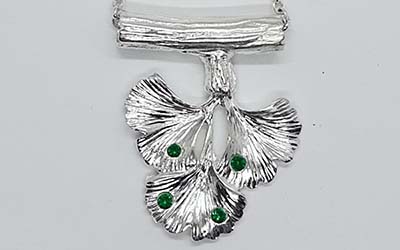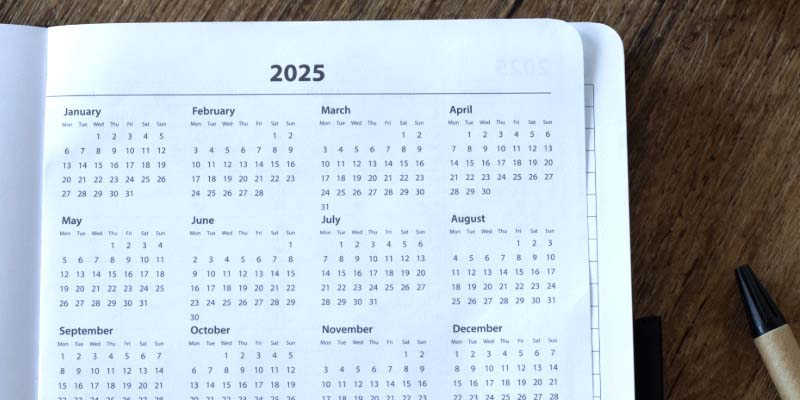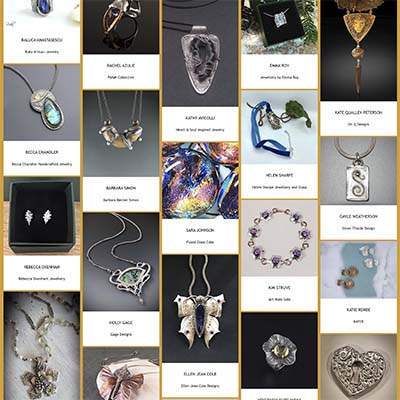Alloy – A mixture of two or more metals that are combined to form a new metal, usually to increase strength or provide resistance to corrosion.
Alum – A food grade powder, found in the spice section of the grocery store, which is used in pickling recipes. When dissolved in warm water it may also be used to remove oxides and other impurities from metal. See pickle.
Alumina Hydrate – A crystalline, water soluble, heat resistant powder used to support dimensional objects during firing, or (sprinkled on a kiln shelf) to create a slippery surface to help minimize distortion during the firing process. Harmful if inhaled!! Use a mask or respirator whenever using Alumina Hydrate.
Bail – The part of a pendant through which a chain is strung.
Base clay – Metal clays such as bronze, copper, and steel, that are not considered precious metals.
Binder – An organic, non-toxic, flammable material that absorbs water and temporarily holds microscopic particles of powdered metal together to form metal clay.
Bronze – A metal alloy usually consisting of 90% copper and 10% tin.
Burnish – To smooth and polish a metal surface with the use of a hard tool, usually polished metal or agate.
Burnout – The period during a firing cycle when binder incinerates and excess water evaporates.
Carbon – A granular material made of coal or coconut used to fire base metal and other clay bodies that require an oxygen free atmosphere in order to sinter.
Cards – Refers to playing cards used as thickness guides or spacers to roll clay to a consistent thickness.
Carve – The process of using a small, sharp blade to incise a design into dry metal clay.
Coil – a cylindrically shaped roll of metal clay. Also called a ‘snake’.
Copper – A pure, unalloyed, reddish-brown metal.
Clay body – Refers to the specific type and brand of metal clay used – such as bronze, rose bronze, copper, white copper, steel, silver, etc. Terminology borrowed from ceramics.
Cutter – A uniquely shaped object with sharp edges, such as a cookie cutter, used to cut clay into decorative shapes.
Dehydrate – The process by which metal clay loses water to the atmosphere, becoming dry – either through natural evaporation or with the aid of an artificially heated atmosphere such as a cup warmer or food dehydrator.
Extruder – A hand held machine that pushes clay through a tube and out a shaped hole or die to form tubes, hinges, bails, and other small elements.
Fiber Blanket – A thick type of heat resistant padding used to support dimensional objects during firing.
Fiber Paper – A thin sheet of heat resistant ‘paper’ used to prevent drag caused by the texture of an uneven kiln shelf during the firing process.
Fine Silver – Pure, unalloyed silver metal. Can be stamped .999.
Fire (v.) – To sinter metal clay in a kiln. Terminology borrowed from ceramics.
Greenware – Metal clay that is formed and dry, but not yet fired. Terminology borrowed from ceramics.
Investment – A plaster-like powder that when mixed with water and allowed to cure, forms a hardened material that will not burn with extreme heat, as in a kiln. Used for casting, in ring molds/plugs and to replicate an implantable (like a cabochon, gemstone or other item) that may not be fired in a kiln.
Keum-Boo – The ancient Korean technique of applying a thin sheet of 22K or 24K gold to silver in order to gild it.
Kiln – A type of furnace capable of reaching the high temperatures needed to sinter metal clay, fire ceramics, or flow glass.
Lavender oil paste – A user made concoction of pure, essential oil (most often lavender oil) and commercially or home made slip/paste used to create a stickier, stronger joining material. Homemade oil paste may be made with any clay body, and may be used with either unfired or sintered metal clay. Approximately 15 – 25 drops of oil to 15 grams of slip/paste is recommended. Adjust the proportions as needed.
Leather Hard – Unfired metal clay in which the water has almost completely evaporated, leaving the clay slightly flexible, yet still fragile. Terminology borrowed from ceramics.
Lubrication – A thin coating of olive oil, olive oil based balms or other preparations that may be used as a release on tools, textures, hands, and other objects, which may come in contact with metal clay.
Metal clay – A generic term referring to a malleable jewelry making/sculpting material made from microscopic particles of metal, binder, and water.
Molding Material – A malleable compound used to recreate the surface of any decorative object. Most often made with a two-part silicone mixture, or with flexible polymer clay.
Needle Tool – See Pin tool.
Open Fire – A first phase firing of base metal or sterling metal clays performed in an open kiln (without the use of carbon) prior to the carbon-firing phase. Ensures a successful burnout of binder materials.
Paper Clay – A solid, flexible type of unfired fine silver metal clay, which is malleable and can be folded, woven or used to cut decorative appliqués. Also known as Sheet.
Paste – A diluted form of clay similar in consistency to nail polish, yogurt, or Spackle, depending on the amount of viscosity desired. Also referred to as Slip.
Patina – a green, brown, or black coloration on metal formed naturally or hastened with chemicals. Often intentionally applied to jewelry to replicate an aged or antique appearance.
Pickle – An acidic solution used to remove oxides and other impurities from metal. A mild, non-toxic pickle can be made with ordinary Alum and warm water.
Pin Tool – Any thin, pointed, sharp object used to cut shapes in metal clay. Typically a dressmakers pin or needle set into a handle.
PPP’s – Photo Polymer Plates, a UV cured product used with overhead projection film, toner, and a black and white image to create a custom texture stamp.
Polymer clay – A malleable plastic material that is used with metal clay to make molds, or forming structures. Must be cured in an oven at low heat.
Ramp – The rate at which a kiln’s temperature rises expressed in degrees per hour. In a Paragon SC-2 kiln, full ramp is equivalent to approx.1792ºF/978ºC per hour.
Rehydrate – The process of adding water to make dry or drying metal clay moist and malleable.
Resist – A substance applied as a coating to protect a metal clay surface during some process, for example using wax, nail polish or other material to create a design on dry metal clay in preparation for water etching or on fired metal clay prior to the patina process; or the application of a non-flammable dust (investment, soldering board, alumina hydrate, etc.) between pieces of touching, dry metal clay to prevent bonding during the firing process.
Ring plug – Also known as a Ring Sizer or Ring Pellet. A cylindrical form made of jeweler’s investment that prevents a ring from shrinking beyond the desired size.
Ring Pellet Mold – A mold that is used with jeweler’s investment to create standard, ring size plugs.
Roller – a tool to form metal clay. A round roller will create a flat sheet of clay; a flat roller will create a cylindrical coil.
Scratch Foam – A low-tech way to create custom texture sheets using Styrofoam (polystyrene sheet) and a rounded stylus or ballpoint pen.
Sheet Clay – A solid, flexible type of unfired metal clay, which can be folded, woven or used to cut decorative appliqués. Also known as Paper.
Shrinkage – Refers to the reduction in size of a metal clay item after drying or firing. Metal clay typically shrinks in mass about 1% during the drying process, and anywhere from 8 to 20% during firing depending on the firing schedule and the specific clay body.
Sinter – The process by which metal particles coalesce or fuse together metallurgically at high temperatures without melting.
Slab – a flat, even, thickness of metal clay after having been rolled out.
Slats – Refers to colored plastic strips, which correspond to playing card thicknesses and are used to roll clay to a consistent thickness.
Spacers – Refers to any type of flat, calibrated strips used on either side of an amount of clay to roll a consistent thickness.
Slip – A diluted form of clay similar in consistency to nail polish, yogurt, or Spackle, depending on the amount of viscosity desired. Also referred to as Paste. May be used to complete repairs, or as a decorative material.
Slip Printing – The method of pushing thick slip through a stencil onto dry clay to achieve a surface decoration or texture. Also referred to as the stencil process.
Slip Trailing – The method of applying viscous slip (made with the addition of an amount of essential oil) in a painterly manner onto dry metal clay to achieve a surface decoration or texture.
Snake – A cylindrically shaped roll of metal clay, also called a ‘coil’.
Steel – An alloy of iron, carbon, and possibly other elements.
Stencil – A thin sheet of plastic, metal, or tape covered cardboard with a pattern or geometric shape cut into it, used to replicate the design on the surface below with an application of slip or by the use of a pin tool to cut out shapes. May also be used to simply press a design into fresh metal clay.
Sterling Silver – An alloy usually consisting of 92.5% fine silver and 7.5% copper. Can be stamped .925.
Syringe Clay – A specific formulation of metal clay the consistency of cake frosting, inserted into a syringe and used to make repairs or decorate the surface of metal clay items.
Tearaway – A method of creating low profile texture sheets using glossy paper, a copier, toner, black and white graphics, heat and friction.
Teflon™ – A flexible, non-stick sheet of plastic used as a subsurface when working with fresh metal clay.
Teflex – The brand name of a type of Teflon™ sheet made by Excaliber.
Texture – Anything that can be used to impress a dimensional design into or onto the surface of clay.
Template – A negative shape in a sheet of plastic, card stock or metal that can be used to cut a pattern in clay.
Thin Fire Paper – Marketed by Bullseye Glass Company, this branded, ceramic-impregnated paper has a smooth surface and is most often used by glass fusers. Because it does not completely burn away during the firing process, it may be used with metal clay as a firing surface (to minimize distortion during shrinking phase), or as a hole cover to block small openings in base clays during the carbon firing process. Breathing Hazard after firing. Wear a mask or respirator whenever using.
Tissue Blade – A long, thin, flat strip of stiff metal that is sharp on one edge – used to cut straight sections of clay.
Torch Fire – The process of sintering metal clay with the use of a hand held torch, most commonly filled with butane gas.
Vermiculite – A naturally occurring mineral composed of shiny flakes resembling mica. More commonly used as a gardening/soil amendment, small nuggets of vermiculite are used in a non-combustible dish to support dimensional metal clay objects during firing. Unnecessary if firing in carbon, but helpful during a first phase open firing.
Water Etching – The method of selectively removing/eroding dry metal clay in a specific design by use of a resist, sponge and water to achieve a surface decoration or texture.












